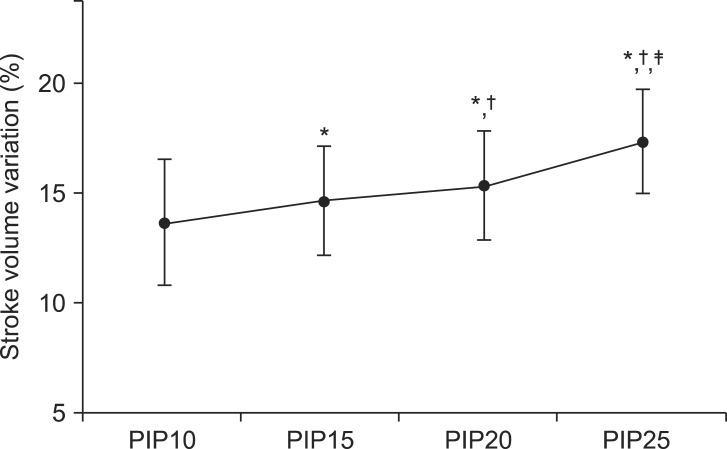1. Zhang Z, Lu B, Sheng X, Jin N. Accuracy of stroke volume variation in predicting fluid responsiveness: a systemic review and meta-analysis. J Anesth. 2011; 25:904–916. PMID:
21892779.
2. Michard F, Teboul JL. Predicting fluid responsiveness in ICU patients: a critical analysis of the evidence. Chest. 2002; 121:2000–2008. PMID:
12065368.
3. Bendjelid K, Romand JA. Fluid responsiveness in mechanically ventilated patients: a review of indices used in intensive care. Intensive Care Med. 2003; 29:352–360. PMID:
12536268.

4. Osman D, Ridel C, Ray P, Monnet X, Anguel N, Richard C, et al. Cardiac filling pressure are not appropriate to predict hemodynamic response to volume challenge. Crit Care Med. 2007; 35:64–68. PMID:
17080001.
5. Choi DY, Kwak HJ, Park HY, Kim YB, Choi CH, Lee JY. Respiratory variation in aortic blood flow velocity as a predictor of fluid responsiveness in children after repair of ventricular septal defect. Pediatr Cardiol. 2010; 31:1166–1170. PMID:
20703453.

6. Byon HJ, Lim CW, Lee JH, Park YH, Kim HS, Kim CS, et al. Prediction of fluid responsiveness in mechanically ventilated children undergoing neurosurgery. Br J Anaesth. 2013; 110:586–591. PMID:
23250892.

7. Pereira de Souza Neto E, Grousson S, Duflo F, Ducreux C, Joly H, Convert J, et al. Predicting fluid responsiveness in mechanically ventilated children under general anaesthesia using dynamic parameters and transthoracic echocardiography. Br J Anaesth. 2011; 106:856–864. PMID:
21525016.
8. Marik PE, Cavallazzi R, Vasu T, Hirani A. Dynamic changes in arterial waveform derived variables and fluid responsiveness in mechanically ventilated patients: a systemic review of the literature. Crit Care Med. 2009; 37:2642–2647. PMID:
19602972.
9. Mesquida J, Kim HK, Pinsky MR. Effect of tidal volume, intrathoracic pressure, and cardiac contractility on variations in pulse pressure, stroke volume, and intrathoracic blood volume. Intensive Care Med. 2011; 37:1672–1679. PMID:
21739340.

10. Reuter DA, Bayerlein J, Goepfert MS, Weis FC, Kilger E, Lamm P, et al. Influence of tidal volume on left ventricular stroke volume measured by pulse contour analysis in mechanically ventilated patients. Intensive Care Med. 2003; 29:476–480. PMID:
12579420.
11. De Backer D, Heenen S, Piagnerelli M, Koch M, Vincent JL. Pulse pressure variations to predict fluid responsiveness: influence of tidal volume. Intensive Care Med. 2005; 31:517–523. PMID:
15754196.

12. De Backer D, Taccone FS, Holsten R, Ibrahimi F, Vincent JL. Influence of respiratory rate on stroke volume variation in mechanically ventilated patients. Anesthesiology. 2009; 110:1092–1097. PMID:
19352152.

13. Keren H, Burkhoff D, Squara P. Evaluation of a noninvasive continuous cardiac output monitoring system based on thoracic bioreactance. Am J Physiol Heart Circ Physiol. 2007; 293:H583–H589. PMID:
17384132.

14. Marqué S, Cariou A, Chiche JD, Squara P. Comparison between Flotrac-Vigileo and bioreactance, a totally noninvasive method for cardiac output monitoring. Crit Care. 2009; 13:R73. PMID:
19454009.

15. Charron C, Fessenmeyer C, Cosson C, Mazoit JX, Hebert JL, Benhamou D, et al. The influence of tidal volume on the dynamic variables of fluid responsiveness in critically ill patients. Anesth Analg. 2006; 102:1511–1517. PMID:
16632835.

16. Lakhal K, Ehrmann S, Benzekri-Lefevre D, Runge I, Legras A, Dequin PF, et al. Respiratory pulse pressure variation fails to predict fluid responsiveness in acute respiratory distress syndorme. Crit Care. 2011; 15:R85. PMID:
21385348.
17. Cannesson M, Aboy M, Hofer CK, Rehman M. Pulse pressure variation: where are we today? J Clin Monit Comput. 2011; 25:45–56. PMID:
20390324.

18. Fiadjoe JE, Feldman JM, Cohen DE. Equipment. In : Davis PJ, Cladis FP, Motoyama EK, editors. Smith's Anesthesia for Infants and Children. 8th ed. Philadelphia: Elsevier Mosby;2011. p. 293–321.
19. Motoyama EK, Finder JD. Respiratory physiology in infants and children. In : Davis PJ, Cladis FP, Motoyama EK, editors. Smith's Anesthesia for Infants and Children. 8th ed. Philadelphia: Elsevier Mosby;2011. p. 22–79.
20. Renner J, Cavus E, Meybohm P, Gruenewald M, Steinfath M, Scholz J, et al. Pulse pressure variation and stroke volume variation during different loading conditions in a paediatric animal model. Acta Anaesthesiol Scand. 2008; 52:374–380. PMID:
18205899.

21. Durand P, Chevret L, Essouri S, Haas V, Devictor D. Respiratory variations in aortic blood flow predict fluid responsiveness in ventilated children. Intensive Care Med. 2008; 34:888–894. PMID:
18259726.

22. Renner J, Broch O, Duetschke P, Scheewe J, Höcker J, Moseby M, et al. Prediction of fluid responsiveness in infants and neonates undergoing congenital heart surgery. Br J Anaesth. 2012; 108:108–115. PMID:
22113930.

23. Renner J, Broch O, Gruenewald M, Scheewe J, Francksen H, Jung O, et al. Non-invasive prediction of fluid responsiveness in infants using pleth variability index. Anaesthesia. 2011; 66:582–589. PMID:
21539529.

24. Ballestero Y, López-Herce J, Urbano J, Solana MJ, Botrán M, Bellón JM, et al. Measurement of cardiac output in children by bioreactance. Pediatr Cardiol. 2011; 32:469–472. PMID:
21318463.

25. Lee JY, Kim JY, Choi CH, Kim HS, Lee KC, Kwak HJ. The ability of stroke volume variation measured by a noninvasive cardiac output monitor to predict fluid responsiveness in mechanically ventilated children. Pediatr Cardiol. 2014; 35:289–294. PMID:
23963186.








 PDF
PDF Citation
Citation Print
Print



 XML Download
XML Download